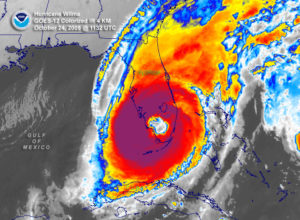IT’S QUIET OUT THERE . . . TOO QUIET—A LOOK AT THE 2016 HURRICANE SEASON
 The season for blizzards has drifted away. The climatological peak for tornadoes and supercells is spinning past us. So now comes the months when we turn a wary eye toward the oceans, and terms such as “storm surge” and “eyewall” begin to creep into our conversations. The 2016 Atlantic hurricane season is officially underway (June 1st).
The season for blizzards has drifted away. The climatological peak for tornadoes and supercells is spinning past us. So now comes the months when we turn a wary eye toward the oceans, and terms such as “storm surge” and “eyewall” begin to creep into our conversations. The 2016 Atlantic hurricane season is officially underway (June 1st).
Not that “officially” means much anymore. Two rogue storms already have thumbed their noses at officialdom this year, Hurricane Alex in January, and Tropical Storm Bonnie just a few days ago.
That aside, I gotta tell you, I’m a bit worried about the impending season. No, I don’t have any secret knowledge about what may or may not happen. My concern is purely statistical. It’s been over a decade since the U. S. has been slammed by a major hurricane, one packing winds in excess of 110 mph.
We’ve never before, at least since 1851, gone 10 years without having a Category 3, 4 or 5 monster swirl over a U. S. coastline. The last major blow to hammer the country was Wilma in October 2005. Wilma blustered into south Florida packing winds of 120 mph.
Wilma, by the way, was also the last of 7 major hurricanes to blast over our shores in just a two-year period, 2004 to 2005. Climatology tells us that such powerful storms make U. S. landfall in about 2 out of every 3 years.
The point I’m trying to make is that we can’t be lucky forever. How many consecutive times can you roll the dice without crapping out? We’re overdue for some bad juju. Obviously, I can’t say where or when. But the bottom line is, if you live in hurricane country, don’t be lulled into complacency by the recent lack of tropical saber rattling.
As they used to say in the old “B” cowboy and Indian movies, “It’s quiet out there . . . too quiet.” Then the arrows would fly.
IMAGE: IR satellite image of wide-eyed (~60 miles) Wilma plundering south Florida on October 24, 2005.
Well Buzz You and I think along the same lines. Today is my 61 birthday. So I was just shy of the Worcester Tornado I was also enutero for the Saint Patrick’s Day Blizzard and a new born for hurricane Diane.in 1955.so every birthday now since he left us, I say a little prayer to our Hurricane Saint Doctor John Hope, to not bless us with anything we can’t cope with. No matter where one lands in the US we have the capability an infrastructure to handle it. None of the Islands, or Certral and South American countries have that. An atypical into Brazil during the Olympics would be disasterous beyond belief. Handling the Olympic’s alone is nearly going to wipe them out, the government is de stabilizing, the emergency would bring it down. Zika would explode. We would end up sending our military in to get our citizens out of there, at the high point of the final run to the White Houe In our country a direct hit on any city,including Miami we can handle. Sandi proved that. It was tough but we managed that. Even a Cat 5 hit direct on anyone with it’s entourage of tornadoes we can handle. Although if it is Miami then every every civilian and Military plane headed out of Florida and the Keys, better be stuffed with food fuel and evacuees and every other airline in the country better participate. Andrew and Wilma have shown how serious a direct hit is. Those two things worry me most. 100% evacuation of the Keys and Southern Fla. Save lives first, worry about property later. So say that prayer to Saint John Hope first to help us protect them all. MikasMom
My family is semi-prepared for hurricane. Lots of devices that operate without electrical power. Lots of food, supplies, stored water, tarps, lumber, etc. The local municipalities have also spent considerable time, money, and training toward being prepared for a large hurricane. Hurricane Ivan had run through here and done some memorable damage. We are fortunate to be heavily forested. The Longleaf Pines, Magnolias, and Live Oaks hold up well to hurricanes and truly are a blessing. They abate the force of the winds. It is the heavy rains that accompany tropical storms and hurricanes that seem to damage the most, especially with homes along creeks and near the Bay being inundated. We are located mostly on friable sand, with occasional arms of clay soils. Erosion is a threat in this area, damaging fields, yards, embankments, and roads.